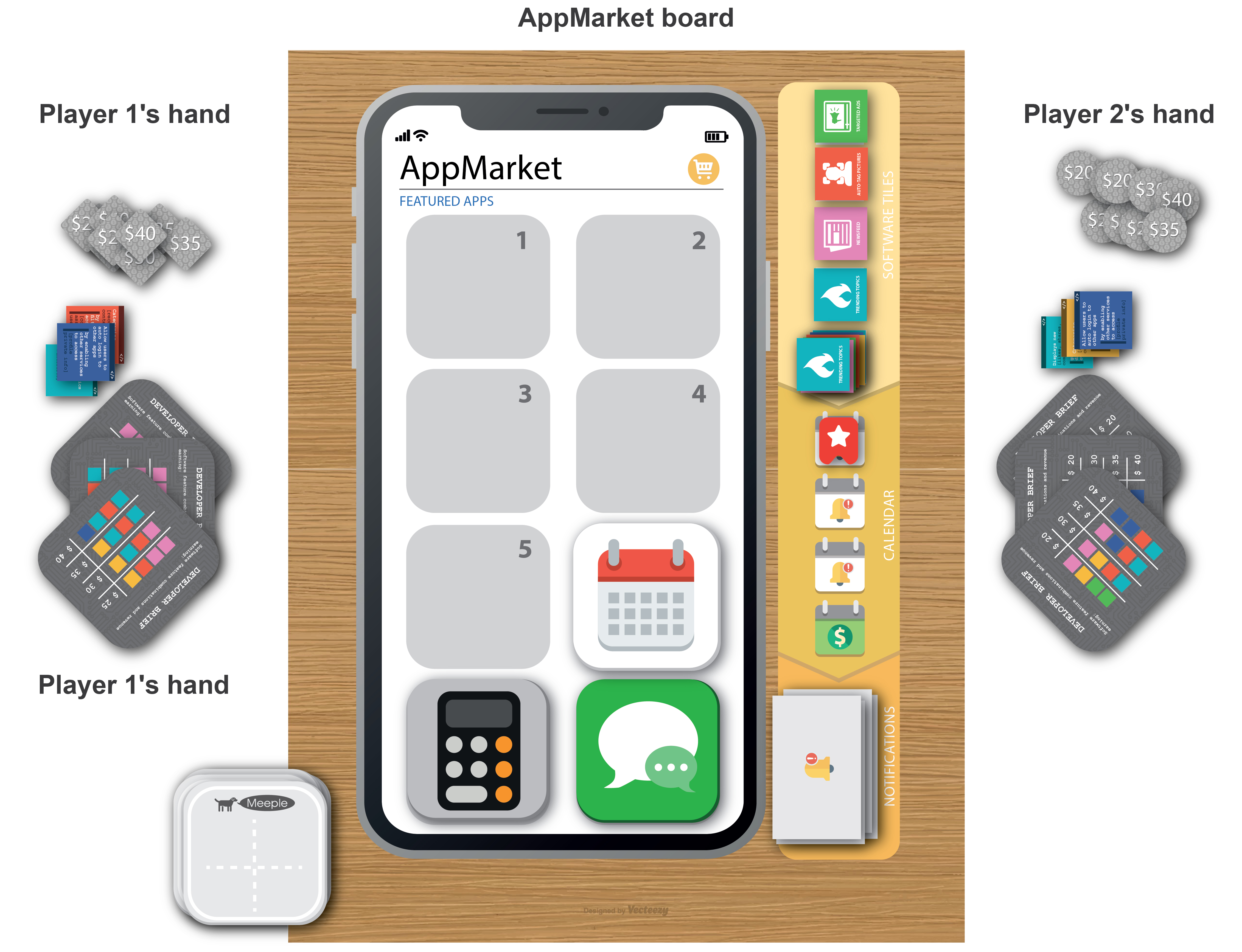LABS 2019
The Leonardo Abstracts Service (LABS) is an evolving, comprehensive database of thesis abstracts (PhD, Master's and MFA) on topics at the intersections between art, science and technology. This English-language database is hosted by Pomona College (Claremont, CA), under the direction of editor-in-chief Sheila Pinkel.
Each year, in addition to being published in the database, a selection of abstracts chosen by a peer review panel for their special relevance are published annually in Leonardo journal (see Vol. 53, No. 5, October 2020) and on our website. We are pleased to present below the top-ranked thesis abstracts of 2019, and we congratulate the authors of the theses.
- Jennifer (Juniper) Harrower: Species Interactions and Climate Change in the Loss of Joshua Trees and the Role of Eco-Art for Understanding Multispecies Connections (Highest-Rated Abstract)
- Janna Ahrndt: Deconstruct and Dissent: Subversive Technologies for the Modern Militant
- Rain Ashford: Responsive and Emotive Wearable Technology: Physiological Data, Devices and Communication
- Kristin Carlson: 'Ah Ha' Moments: Novice Choreographers Using Defamiliarization in Digital Choreographic Technologies
- Kathleen Deck: Enviro-Envision Visualizing Climate Change through Art
- Mario Duarte: DNA and RNA Sequences as Systems for Music Composition: Portfolio of Compositions
- Lucie Lederhendler: Of Ice Shields, Oceans, and Train Yards: Research-Creation Towards Mythological Contact with a Feral Terrain
- Joo Yun Lee: Infinitesimal to Infinity: Ryoji Ikeda’s Data Composition and Space of Sensing
- Louise Mackenzie: Evolution of the Subject: Synthetic Biology in Fine Art Practice
- Giusy Pirrotta: Moving Image And The Space Around The Frame: Time-Based Installations and Forms of Experience
- Sanjay Sahota: Alternative Aesthetics of Inclusive Design
- Valentina Serrati: 3047 - A Dark Room Body
- Vygandas "Vegas" Šimbelis: Humanizing Technology Through Post-Digital Art
- Chelsea Thompto: Productive Bodies
- Jessica Tyrrell: The South Sydney Project: Interaction and Archive Aesthetics
- Clea Theresa von Chamier Waite: Somatic Montage: Supra-Dimensional Composition in Cinema and the Arts
- Karla Zavala and Adriaan Odendaal: Unveiling Interfaces: A Software Studies Board Game for Algorithmic Literacy
Species Interactions and Climate Change in the Loss of Joshua Trees and the Role of Eco-Art for Understanding Multispecies Connections
Juniper Harrower
Human induced global change has greatly contributed to species loss with profound consequences for humans and other organisms. With the rapid pace of climate change and the slow adoption of sustainable actions, I argue that art-science integrated research can enhance our understanding of interspecies connections and support the development of sustainable societies. Working with iconic Joshua trees as a symbol of the nature/culture interface, I take an ecological, eco-art, and multispecies studies approach to understand the ways that climate change impacts the important symbiotic interactions that regulate Joshua tree distribution and how art can provide a meaningful connection to that work. First, I characterize and quantify populations of Joshua trees and their key symbionts – moth pollinators and mycorrhizal fungi – across a climate gradient, to understand how their context-dependent associations change with climate and the resulting implications for tree survival. Next, I discuss how those ecological findings, when colored by Donna Haraway’s multispecies studies approach, influence my multimedia social practice art work Staying with the Trouble for Joshua Trees, a practice that engages diverse communities in the experience and discourse of species loss through an experimental and conceptual painted soil study, the creation of a stop motion animation, and a mock online dating site to meet Joshua trees.
Juniper Harrower: jharrower@ucsc.edu. PhD thesis, University of California Santa Cruz, 2019.
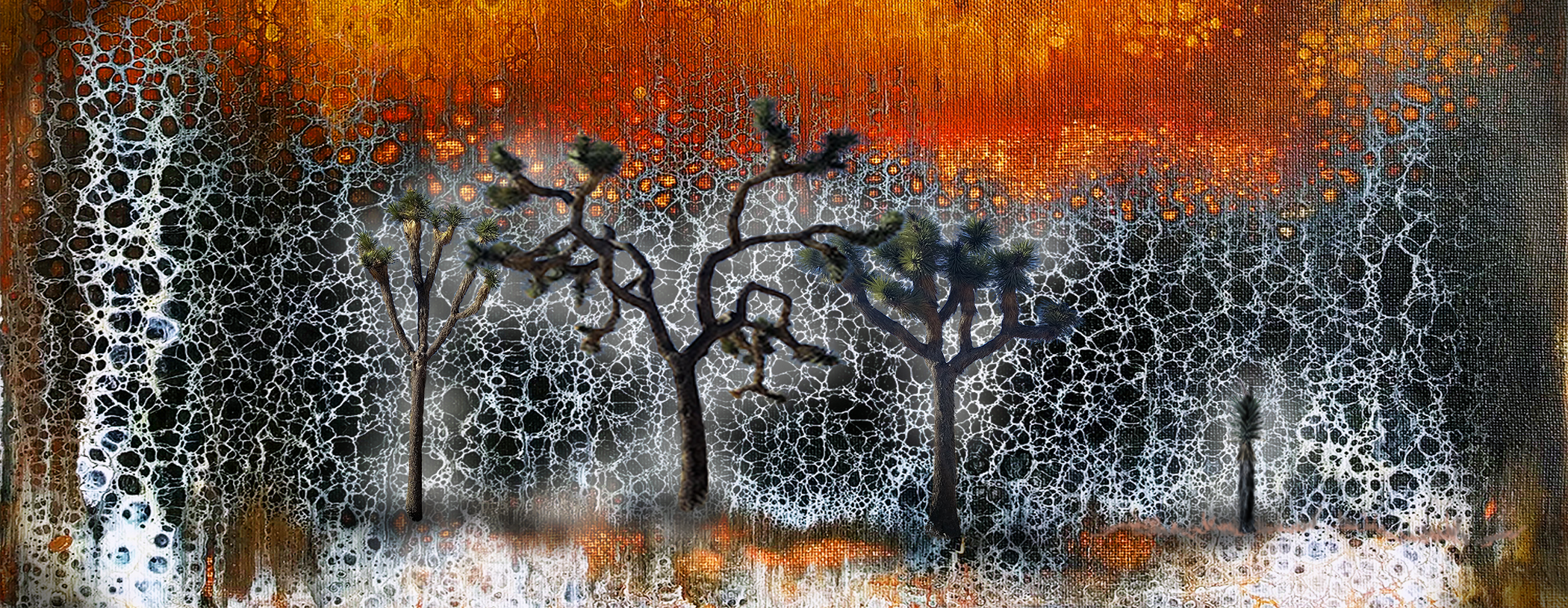
Joshua trees and soil fungi across a climate gradient. Acrylic, Joshua tree seed oil. © Juniper Harrower
Deconstruct and Dissent: Subversive Technologies for the Modern Militant
Janna Ahrndt
In combining Maktivism and Craftivism, I believe a more effective feminist political art medium is created. This combination serves to critique not only targeted political issues, but also the exclusionary practices in technology along gender, class, and racial lines. As an artist working at the intersection of craft and new media art, I feel this combination also provides a perfect medium to question the links between current exploitative economic systems that control the production of textiles and information and communication technology (ICT). My focus is on finding ways to engage communities in civic action while honoring the integrity at the heart of the DIY movement.
In the following sections, I discuss my attempt to combine tactical media and social aesthetics as a way to democratize political interventionist art and the merits of maker and craftivist movements to shape these interventions. I will outline a series of attempts to generate political artworks created at the intersection of art, DIY technologies and feminism as a way to offer a mode of feminist activist art praxis. These artworks demonstrate different ways I position my practice within the ethical framework of these movements.
Janna Ahrndt: janna.ahrndt@gmail.com. MFA thesis, Purdue University, 2019.
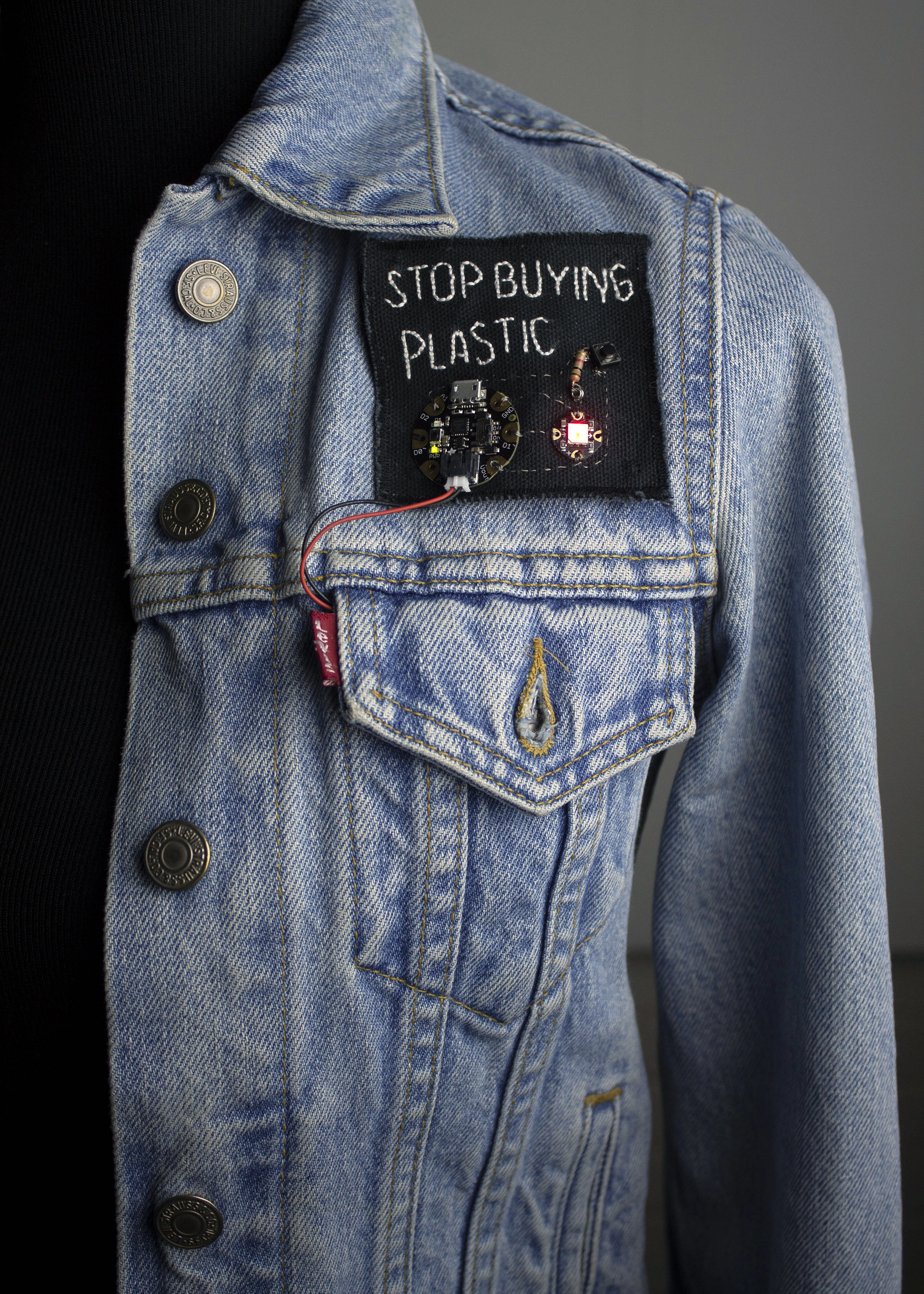
P@tch Iteration 1, 2018 (© Janna Ahrndt)
Responsive and Emotive Wearable Tech: Physiological Data, Devices and Communication
Rain Ashford
My research investigates how wearable technology can be used to create new forms of nonverbal communication. Using devices developed through my practice, I explore how physiological data can be visualised and broadcast. I examine the opinions and requirements of potential users through qualitative responses in interviews and surveys from focus groups and field tests. I analyse the resulting data to extract preferences and concerns, plus requirements for the functionality and aesthetics of these devices. I discuss the social and cultural aspects of wearing such devices, including how privacy may be affected, and the implications of recording personal data.
I examine my practice in the context of the work of the communities and practitioners in the field, and as part of my distinctive contribution introduce two new terms for sub-sections of wearable technology. These are ‘responsive wearables’ and ‘emotive wearables’. I identify and share insights into the disciplines and processes required for the fusion of technology and design successfully to evolve electronics, code and materials into research prototypes.
I conclude by discussing findings and comment on the impact that physiologically sensing wearable technology has on aspects of social interaction for the individual as well as for the wider community. I open the discussion on future research by revealing two new examples of emotive wearables evolved from pinpointing specific areas of user studies feedback.
Rain Ashford: r.ashford@gold.ac.uk. PhD thesis, Goldsmiths, University of London, 2018.
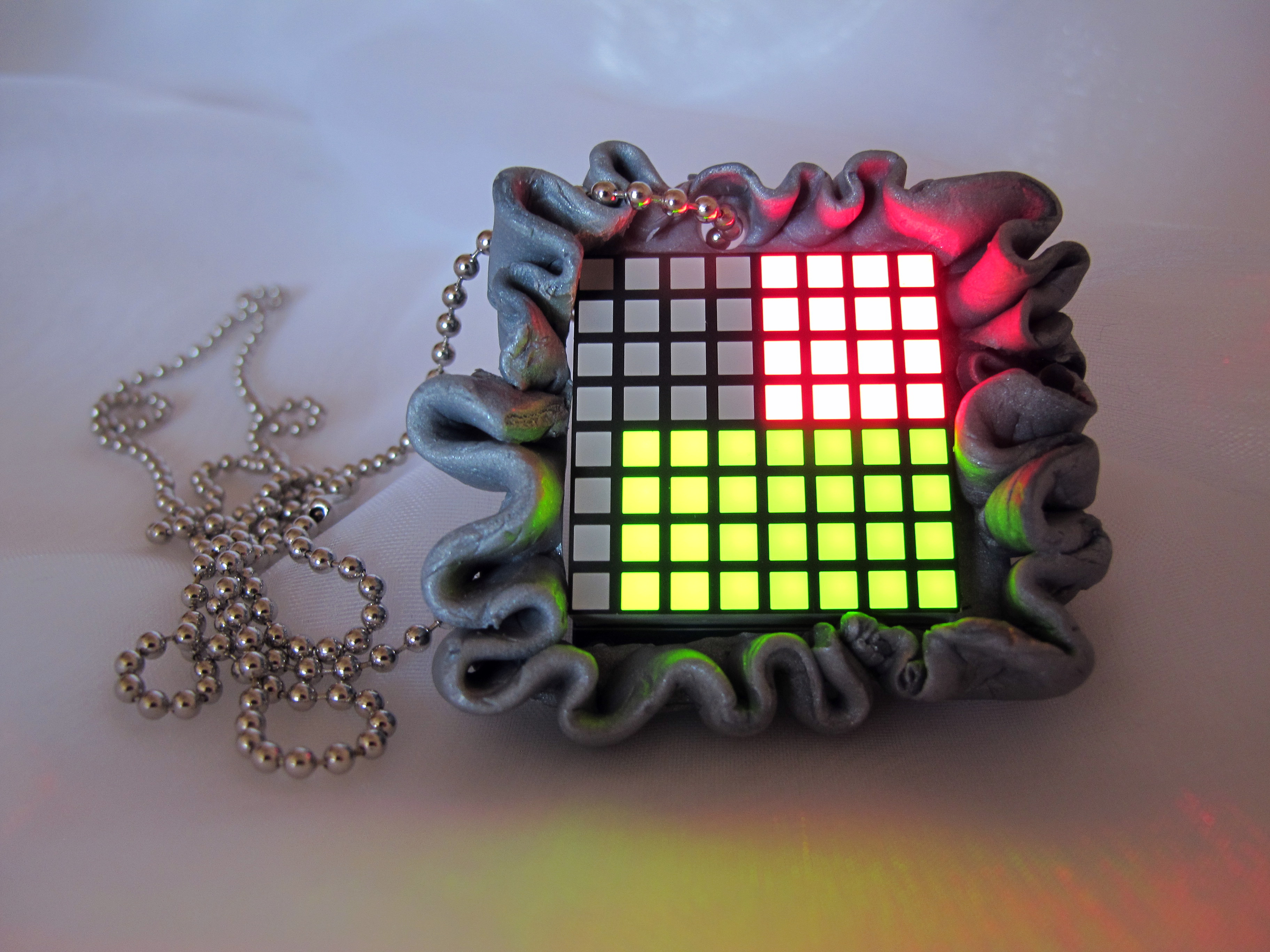
EEG Visualising Pendant © Rain Ashford
'Ah Ha' Moments: Novice Choreographers Using Defamiliarization in Digital Choreographic Technologies
Kristin Carlson
Kristin Carlson
Choreography is a complex compositional process that often relies on ‘co-imagining’ between choreographer and dancer. Adding technology is a unique challenge because choreographers generate, adapt, and assess movement through and on their bodies. Technology has historically been used as a tool to augment creative opportunities in choreographic process; yet often tools are designed as a ‘blank slate’ for choreography which do not necessarily contribute to the co-imagination of creative ideas. My research investigates the experience of novice choreographer’s ‘ah ha’ moments in their creative process by addressing a gap that exists within current digital choreographic creativity support tools. This gap is the ability to co-imagine novel movement choices between choreographer and technological support system. In the research presented in this thesis, I explored the concept of applying generative algorithms in the creation of movement catalysts that can propose novel choices to the choreographer. I have designed, implemented and evaluated these generative choreographic procedures (which I have titled ‘Cochoreo’) to the existing choreographic support tool ‘idanceForms’ (idF). Novice choreographers were asked to design short choreographies using idF. Data was collected through observation and focus group discussions and analyzed through grounded-theory inspired thematic methods. The contribution of this work situates the design and practice of interactive choreographic systems within creativity theory to explore future design of iterative and provocative technology for supporting movement, creativity and co-imagination.
Kristin Carlson: kacarl1@ilstu.edu. PhD thesis, Simon Fraser University, 2016.
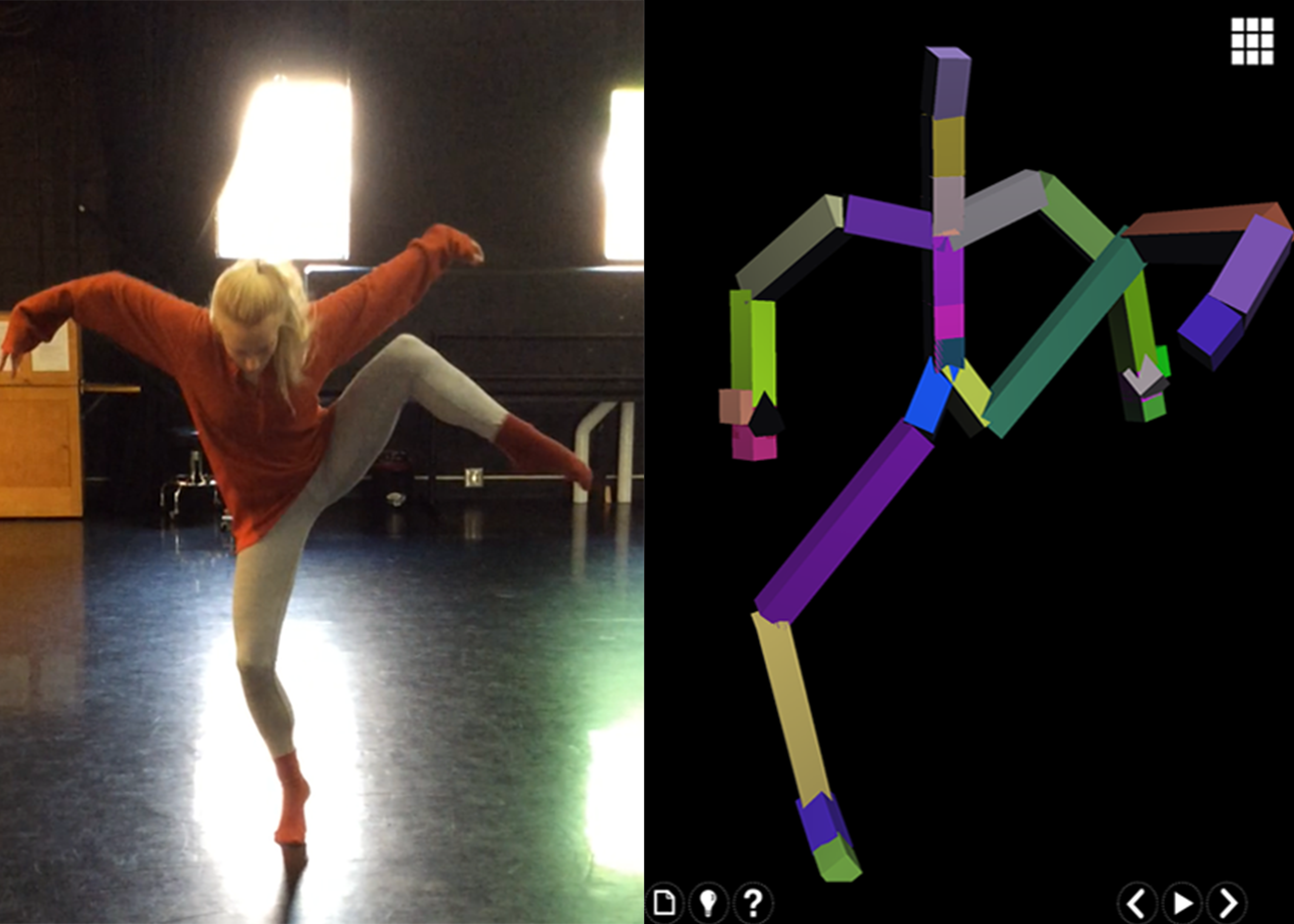
Cochoreo © Kristin Carlson
Enviro-Envision, Visualizing Climate Change through Art
Kathleen Deck
From the beginning of the environmental movements of the 1960s, humans have sought to convey messages of the tragedy of human destruction of the earth. Since then, the world has shifted greatly, and the extent and effects of climate change have become more apparent, yet most humans still cannot fully comprehend the “hyperobject” of climate change. Art with its emotional qualities has been seen to illicit change and comprehension of complicated issues like climate change.
In this thesis it is argued that eco-art and new media art practices, together, can effectively communicate the effects of climate change. The ecologically themed new media art project Enviro-Envision, which is an interactive installation showing the effects of human impact and climate change on the past, present, and future of a Santa Cruz coastal redwood ecosystem, illustrates how innovative and vital such interdisciplinary projects can be in communicating climate change. The digital, interactive, and figurative data visualization approaches are compared in context with other contemporary projects and their strategies for the creation of a work with a climate change theme.
Kathleen Deck, enviroenvision@gmail.com. MFA, UC Santa Cruz, 2019.
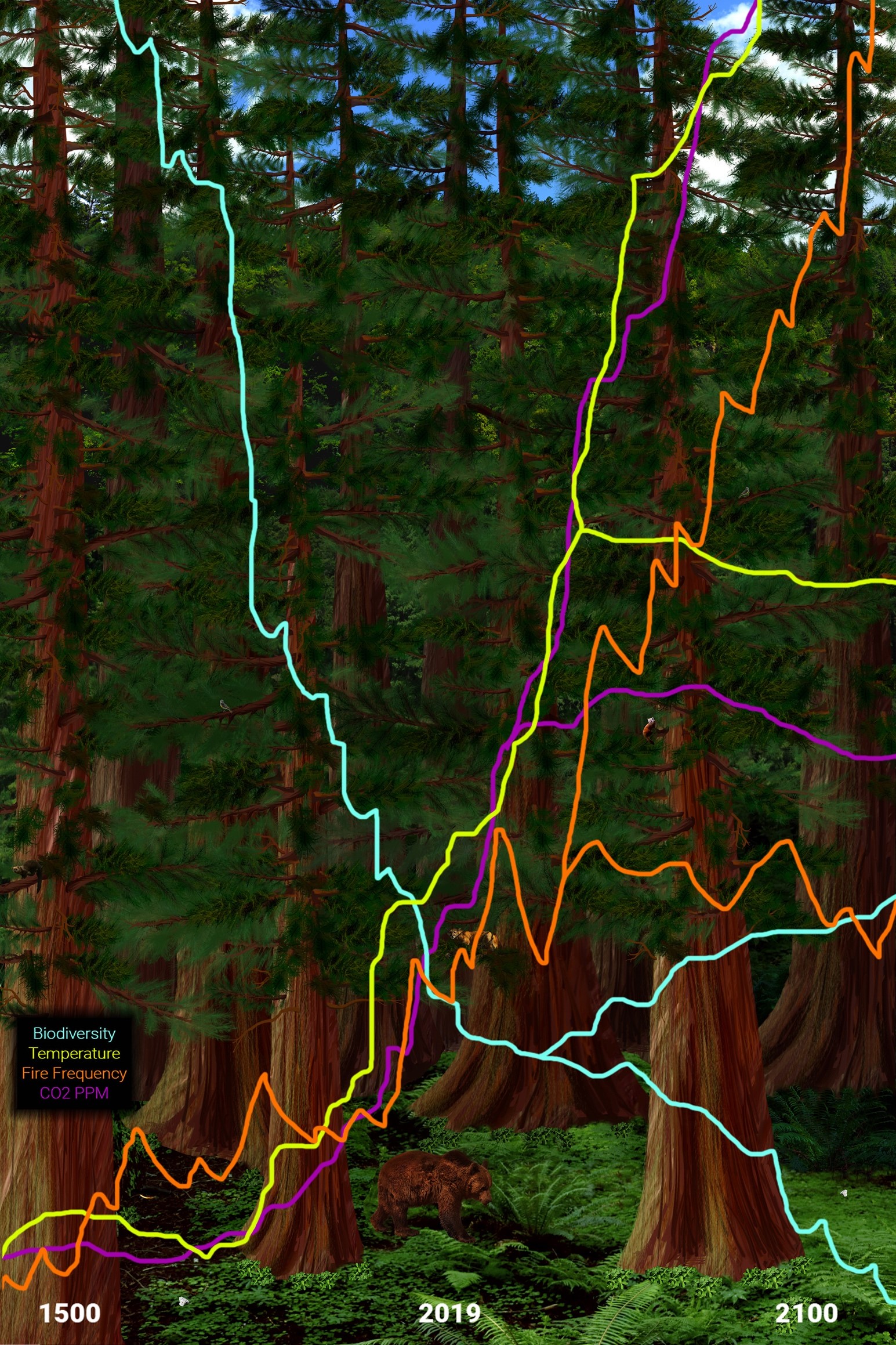
Digital paint and photography showing a thriving Santa Cruz coastal redwood ecosystem in year 1500, as seen in the interactive program Enviro-Envision at the Receivership Exhibition.(© Kathleen Deck)
DNA and RNA Sequences as Systems for Music Composition: Portfolio of Compositions
Mario Duarte
This Thesis researches the use of DNA sequences as a system for music composition. The main objective is to identify and create musical expression using sequences of DNA, which carry embedded structure and organisation.
An effective model of DNA sonification was implemented through the use of a Parameter Mapping Sonification Interface that can obtain a musical rendering of the genetic material through the replication of different stages of DNA coding. In this way the composer could make compositional decisions a priori in mapping musical parameters (musification) and make use of sonification as a tool in order to successfully generate, organise and develop musical material in a compositional system based on DNA and RNA sequences. This is in contrast to a hard scientific sonification perspective, where unedited outputs are presented as a musical composition.
As a result, the portfolio provides an intelligible corpus of music that integrates science, literature, cultural heritage and the social sphere in order to deliver my musical discourse. Nine compositions are presented in the portfolio, each of these explores the use of sonification and musification as a compositional tool to generate and organise musical materials.
Mario Duarte: mduarte@enesmorelia.unam.mx. PhD thesis, The University of Manchester, 2017.
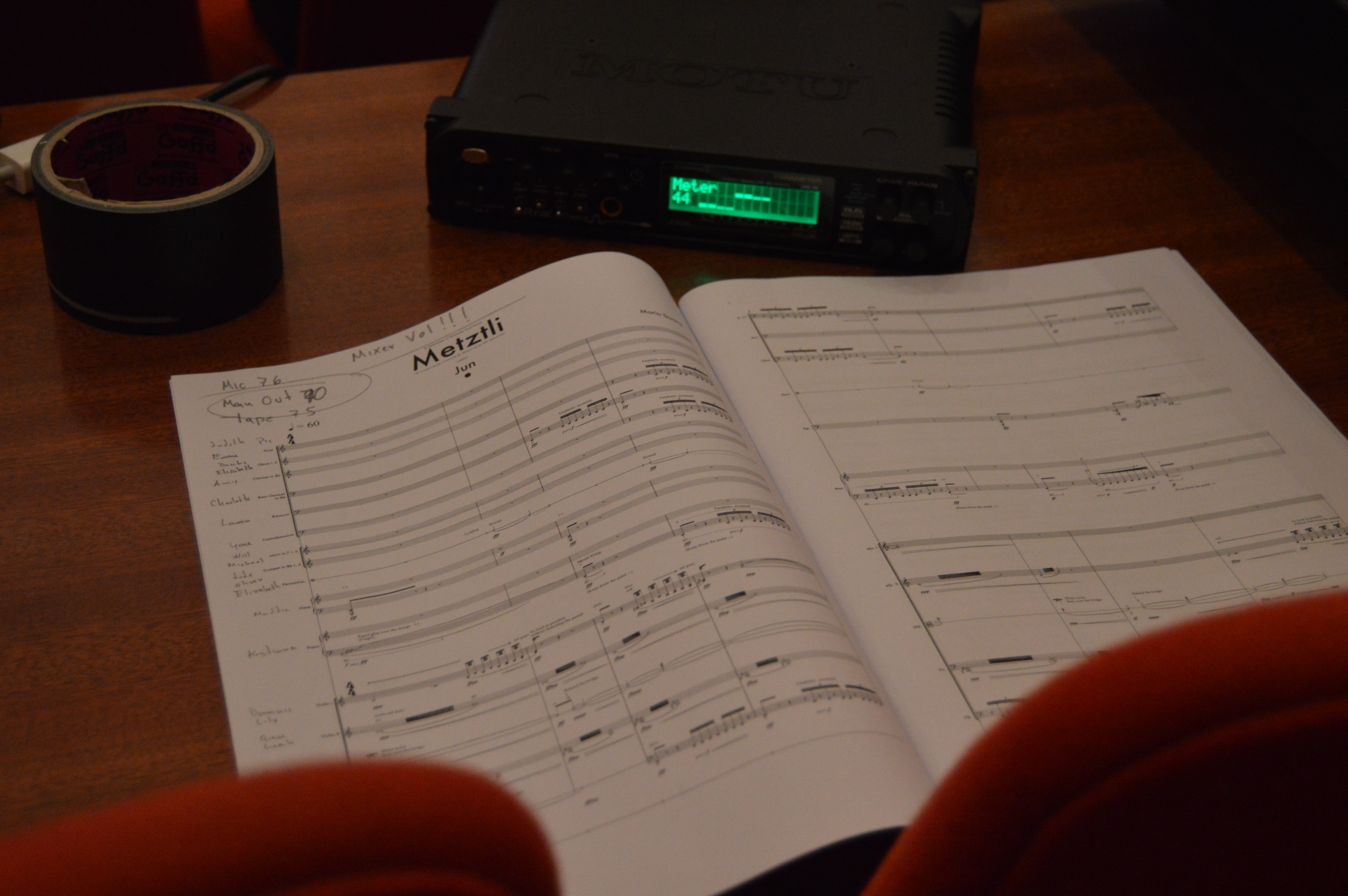
Metztli for orchestra and electronics, 2017. (© Mario Duarte)
Of Ice Shields, Oceans, and Train Yards: Research-Creation Towards Mythological Contact with a Feral Terrain
Lucie Lederhendler
This project is a speculative account that reflects on the artist-as-witness to the de-enchantments and re-enchantments of a feral terrain in post-industrial Montreal, Canada. Taking advantage of the confluence of this research and a renewal in the city's interest in the site, the project calls into question the stark binaries that the idea of a separate "nature" implies. It builds on the work of art educators and academics who have resisted the siloing of art, focusing on merging public policy and place histories into an environmental art project. Content provided by implicated community members, the author's own experience, and scholarly and archival research coalesce into mythologies, articulated through visual arts. Artworks, used in this way, act as filters through which the viewer's understanding of geological scale may be shaped, translating the stories of millennia into decades, years, or moments. Finally, this research models how mythologies that foreground connections to the land, following from Indigenous Canadian knowledge, may offer a literal framework for seeing and relating to urban forms of nature. A field guide and zoetrope installations function as augmented reality machines that superimpose geological and mythological time onto the immediate present, literally and figuratively animating the landscape for the viewer.
Lucie Lederhendler: lucie.lederhendler@gmail.com. MA thesis, Concordia University, 2019.
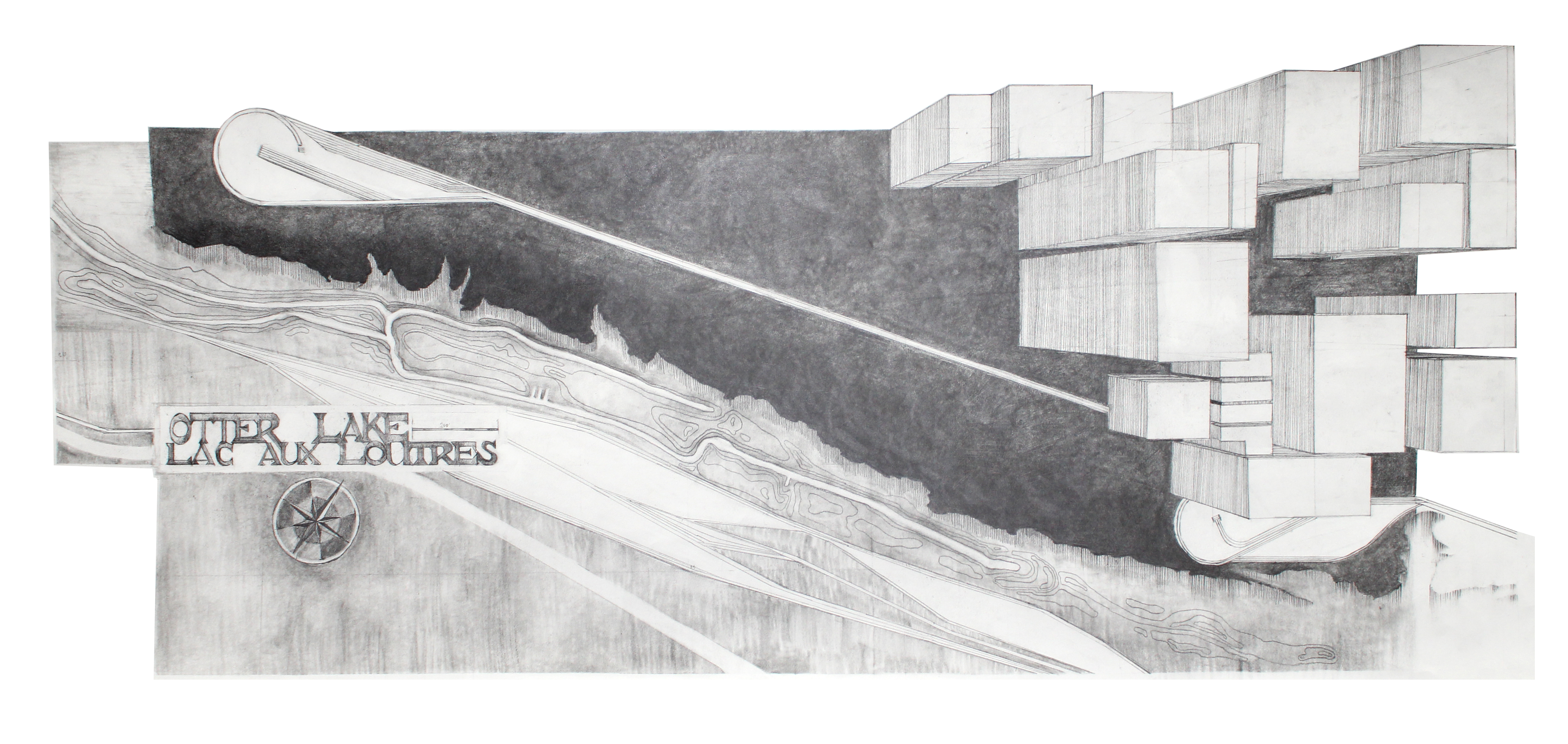
Lac au loutres, Otter Lake. 2017. Graphite on paper. 98 x 43 cm (© Lucie Lederhendler)
Infinitesimal to Infinity: Ryoji Ikeda’s Data Composition and Space of Sensing
Joo Yun Lee
This dissertation examines Japanese composer and visual artist Ryoji Ikeda’s audiovisual work at the intersection of sound, art, digital computation, and data that has evolved over the last three decades.
It begins by examining the evolution of Ikeda’s art in the “aesthetic revolution in the 1990s,” particularly from his association with laptop music and with Japanese artist collective Dumb Type. It also illuminates Ikeda’s unique minimalist work’s art-historical and media aesthetic links from the sound practice and visual art from the 1960s and ‘70s, while discussing the specificities that Ikeda’s art opened up a new domain of the audiovisual practices encompassing social critiques of datafied society.
Then, it examines Ikeda’s data composition—certainly evolved from his music composition—that articulates sonic, visual, and numeric data from the infinitesimal to the infinite. Ikeda’s work juxtaposes the unimaginable vastness of datascape and the infinity both of the subatomic dimension and the astronomical universe, exploring the intersection of sound, data, and matter. The matrix of data, however, is not meant to be decoded nor interpreted in the linguistic sense. It contends that, by unveiling the microactivity of digital computation and the “temporal processuality” of data processing at the threshold of the viewer’s perception and cognition, Ikeda’s work conjures a space of sensing, linking computation and data to new sensations.
Joo Yun Lee: jooyun.lee01@gmail.com. PhD thesis, Stony Brook University, 2018.
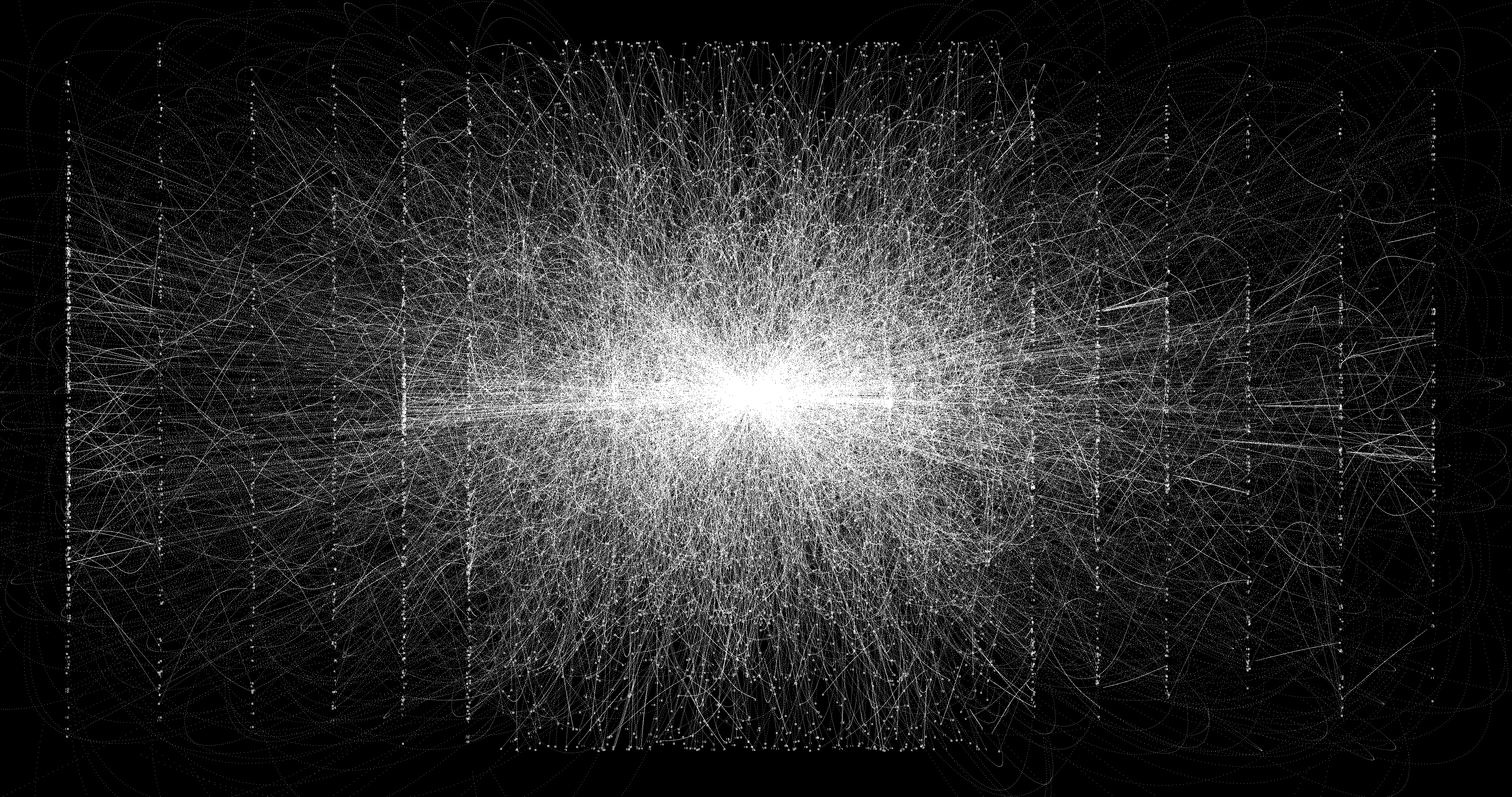
Ryoji Ikeda, data-verse 1, 2019. © Ryoji Ikeda Studio
Evolution of the Subject: Synthetic Biology in Fine Art Practice
Louise Mackenzie
Acknowledging a rise in the use of synthetic biology in art practice, this doctoral project draws from vital materialist discourse on biotechnology and biological materials in the works of Donna Haraway, Jane Bennett, Rosi Braidotti and Marietta Radomska to consider the liveliness of molecular biological material through art research and practice. In doing so, it reframes DNA and the micro-organism through anthropomorphic performative practice that draws on myth and metaphor to allow readings of material that account for liveliness rather than use as resource. As such it contributes to performative, environmental and ecological art practices that question our cultural entanglement with material and the nonhuman.
The core of the research resides in artistic practice situated within the Institute of Genetic Medicine, Newcastle, where I store my thought physically within the body of the living organism, Escherichia coli. The thesis does not recount a bioart practice, but a fine art practice that uses performative strategies to think with the act of using life as material. As such, the thesis questions existing histories of scientific knowledge and proposes alternative stories that reframe aspects of laboratory practice through an aesthetics of care. Further, practice-based aspects of the research contribute to the expanded field of sound and sonic art to develop technologically embodied approaches for listening to laboratory life.
Louise Mackenzie, info@loumackenzie.com, PhD, BxNU, Northumbria University, 2017.
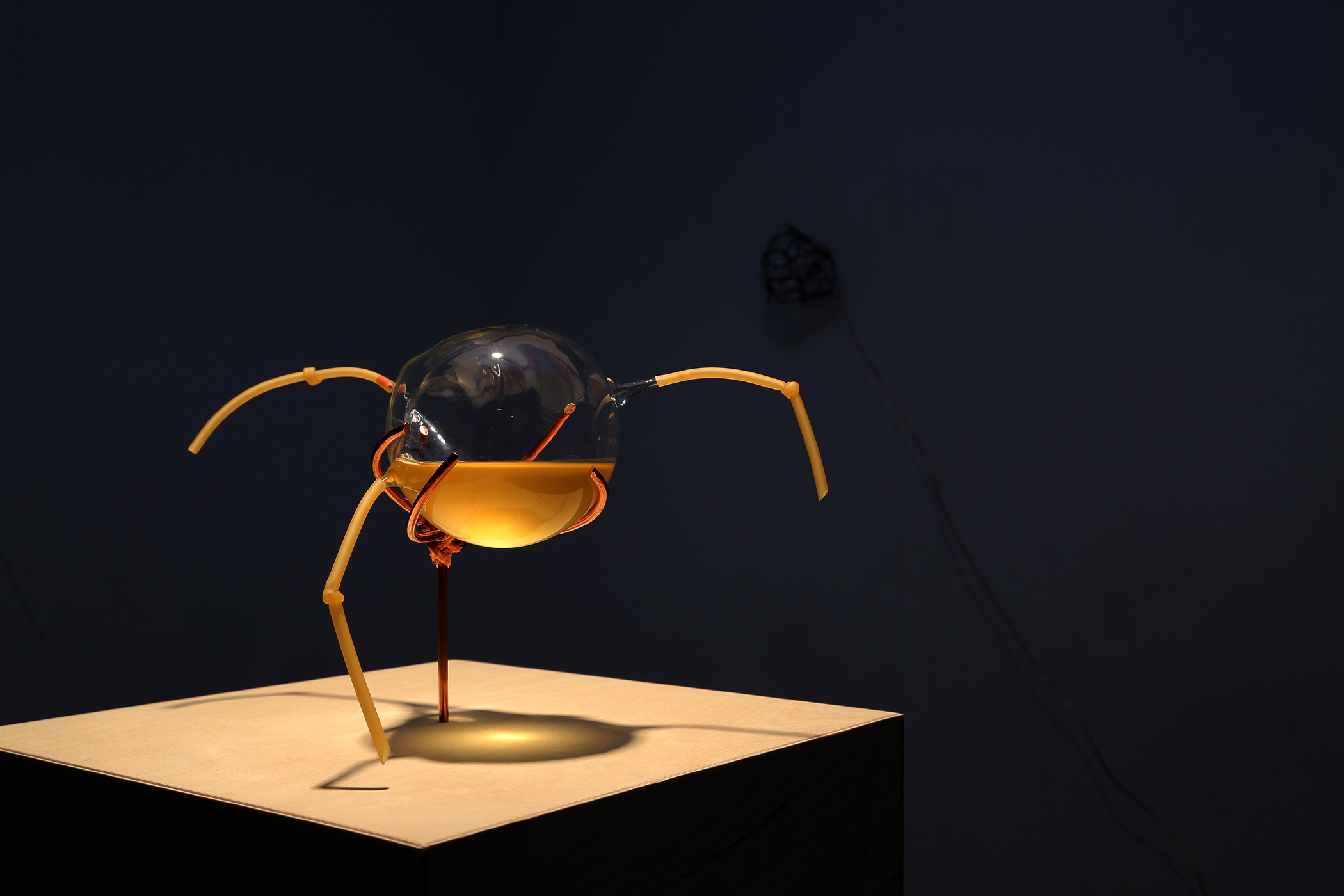
Evolution of the Subject, 2018. Installation detail. (© Louise Mackenzie)
Moving Image And The Space Around The Frame: Time-Based Installations and Forms of Experience
Giusy Pirrotta
This practice-based research examines the relationship between the historical framework of Expanded Cinema and contemporary time-based installations by observing the revival of analogue media and the formal implications in re-exhibiting Expanded Cinema works in the contemporary museum. It investigates contemporary artistic practices where the use of analogue media and the sculptural manipulation of the projection process contribute to a reinvention of the grammar of the cinematic apparatus. The inquiry observes the self-referential aspect of the elements belonging to film and their displacement from the cinema into the more experimental exhibition setting of the gallery. It analyses the light beam–as a projective and sculptural element–and the deconstruction of the fixed cinematic experience in relation to the screen and the perspectival representation of space.
The theoretical and practical approach contributes to the observation of the perception mechanisms triggered by different levels of immersive experience in the exhibition space. This research aims to re-define the reception of contemporary moving image installations, through the analysis of the space around the screen and the observation of works where the movie theatre architecture is transformed inside the gallery and the museum context. This framework of observation aims to further the understanding of moving image today in relation to history, artists’ choice of media and contemporary exhibition trends.
Giusy Pirrotta: pirrotta.giusy@gmail.com. PhD, UCA Farnham and University of Brighton, 2018.
Alternative Aesthetics of Inclusive Design
Sanjay Sahota
Musical instruments started to become more technologically advanced in the 20th century. Here, the word advanced also includes the idea of being more accessible to more people (a popular example is the synthesiser.) Today, in 2018, even disabled musicians have the chance to play musical instruments as the accessibility factor has come so far. However, in designing instruments to be so accessible, some of the obscurity and awe has been lost in the design content. Historically, musical instruments evoke (visually as well as sonically) awe, obscurity and danger. For example the saxophone, today it is commonplace, but was considered abstract and alien during the time of its invention and popularization. The reason for this element of the design being lost is that design thinking rarely engages with disability beyond something which is a “problem of usability.” To be clear, my research is not calling for the rejection of inclusive design practices and processes, rather, a change in the way that inclusive design is understood.
My research asks the question “could accessible instruments for disabled musicians be designed in such a way that they visually evoke obscurity, danger and violent theatrics during a musical performance?” The first section provides a context for the history of inclusive design, the second section provides speculative/post optimal design solutions /alternatives to address the question at hand.
Sanjay Sahota, sahotasanjay918@gmail.com, MA, Cardiff Metropolitan University, 2018.
3047 - A Dark Room Body
Valentina Serrati
The enmeshment of stories and theories in time and space about the future of human techno-biological body is the starting point of project 3047 - A dark room body. The facts and fictions of present discourses continue to construct false problems of possible lived imaginary beings and the conditions of development of their environments.
3047 intends to explore and critique some of the determinist dichotomies that had prevailed in the research of artificial life and artificial intelligence developments and perception of what future life forms should look like: the organic versus the artificial, the virtual against the real; the theories of natural evolution confronted with culture’s technological developments in biotechnologies and technoscience. More specifically the project focuses its critique on the efforts to erase embodiment within artificial life discourses and the accent on autonomous agency. The artificial life debates raise a well-known problem on corporeality as the remains of something technology wants to substitute or displace. Inside the long tradition of computer science incorporating biological principals, cyberfeminism might bring into focus the question of the agency offering a more extensive perspective for the discussion of identity, belonging and being.
Video-perforance as a creative practice introduce into an installation environment, reflects on the concept of performativity as a way to acquired knowledge not from mere representation, but through lived experience.
Valentina Serrati: valentinaserratisisa@gmail.com. MA Digital Media & Cultural Technologies thesis, Goldsmiths University of London, 2017.
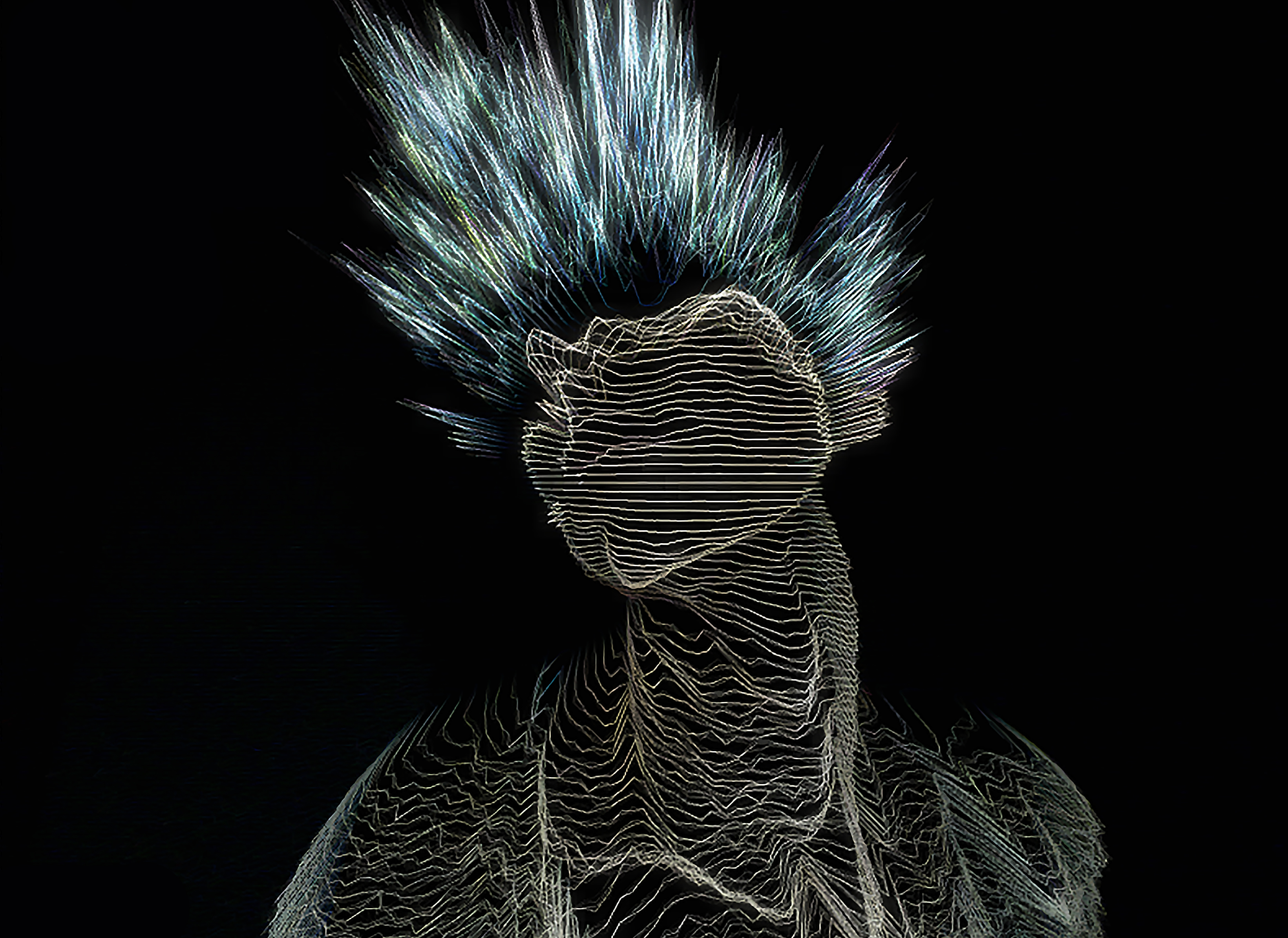
Avatar 3047, 2017 (© Valentina Serrati)
Humanizing Technology Through Post-Digital Art
Vygandas "Vegas" Šimbelis
The research in terms of humanization of technology as a scope for artistic practice and research comprises of the post-digital dimension, in this regard, manifesting of digital qualities in the physical world and through enriching our experiences with hybrid constellations of techniques, concepts and aesthetics.
The overarching approach of interpretative digitality is accounted with four projects: Metaphone, Delete By Haiku, STRATIC, and Panorama Time. In these, the post digital manifests through the hacking activities, disruptive techniques, machinic principles, infrastructures, and systematic behaviours thriving on a set of constitutive concepts: machine aesthetics, digital upcycling, aleatoricism and chance, deletion, repetition, fault aesthetics and glitch aesthetics. Machine aesthetics expose operational and mechanical principles and behaviours. The introduced digital upcycling is a repurposing design process wherein “function follows form” to add value to old defunct objects. Chance is deployed through a “rolling a dice” approach in design processes. Deletion and repetitive insertion is used as design principle. Technical fault and deliberate control of machine glitches are induced to inspire design narratives.
These aesthetic approaches transform the cold appearance of information technologies, rethink the reductionist account and reinterpret the digital positivist-solutionist attitude in computational procedures and its quantitative methodologies. As such these aesthetic principles are ways of interrogating the digital thriving off a cultural-historical point of view.
Vygandas "Vegas" Šimbelis: vygandas@kth.se. PhD, thesis, KTH Royal Institute of Technology, Stockholm, Sweden, 2018.
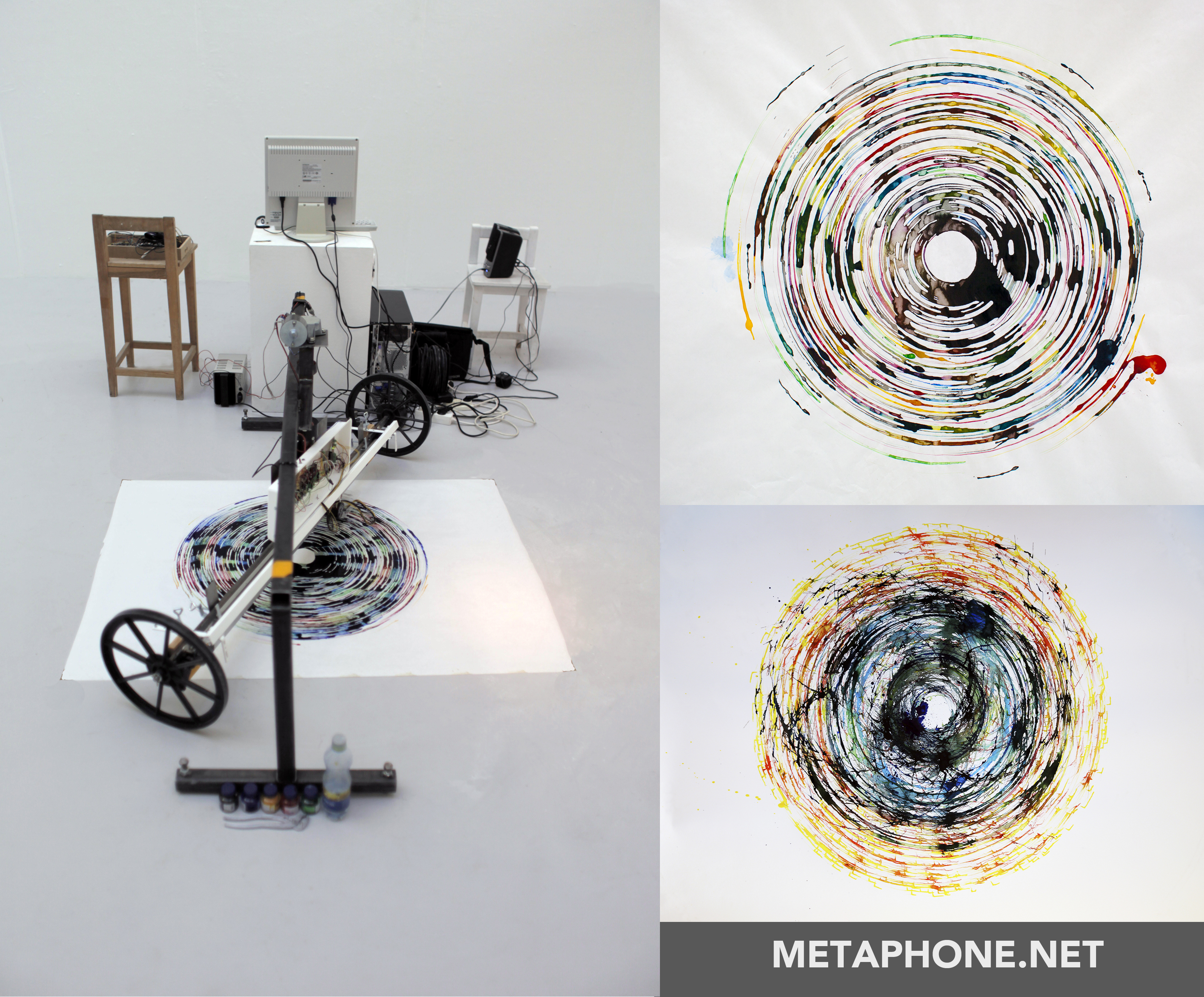
METAPHONE, interactive art installation. (© Vygandas "Vegas" Šimbelis)
Productive Bodies
Chelsea Thompto
Productive Bodies explores questions of visualization as violence, technology in relation to the body, and western society’s conceptions and renderings of bodily boundaries. Trans as a theoretical and artistic gesture of moving across, beyond, and through is enacted through a sustained investigation of how fluid bodies are rendered as fixed through geographic and medical mappings and borders.
The Mississippi River, the river I grew up next to, has been subjected to the scrutiny of western technologies of seeing and modification with the goal of making it known and useful for western militaristic and economic development. Through these technologies, the river has become highway, amusement park, food source, and more. Western modes of visualization have also been entangled with the concept and production of “transgender” as a category of disorder, medical research, social/political argumentation, and more. Through researching how these forces have come to shape our expectations of both the river and trans bodies, this project examines how modes of visualization may violently delimit the livable futures open to the bodies in question.
A transdisciplinary project, Productive Bodies includes archival research, procedurally generated audiovisual art installations, writings, presentations, artist books, and more in order to draw the viewer into an affective exploration of what it means to inhabit a fluid body mapped into fixed borders.
Chelsea Thompto: chelseathomptoart@gmail.com. MFA thesis, University of Wisconsin Madison, 2019.
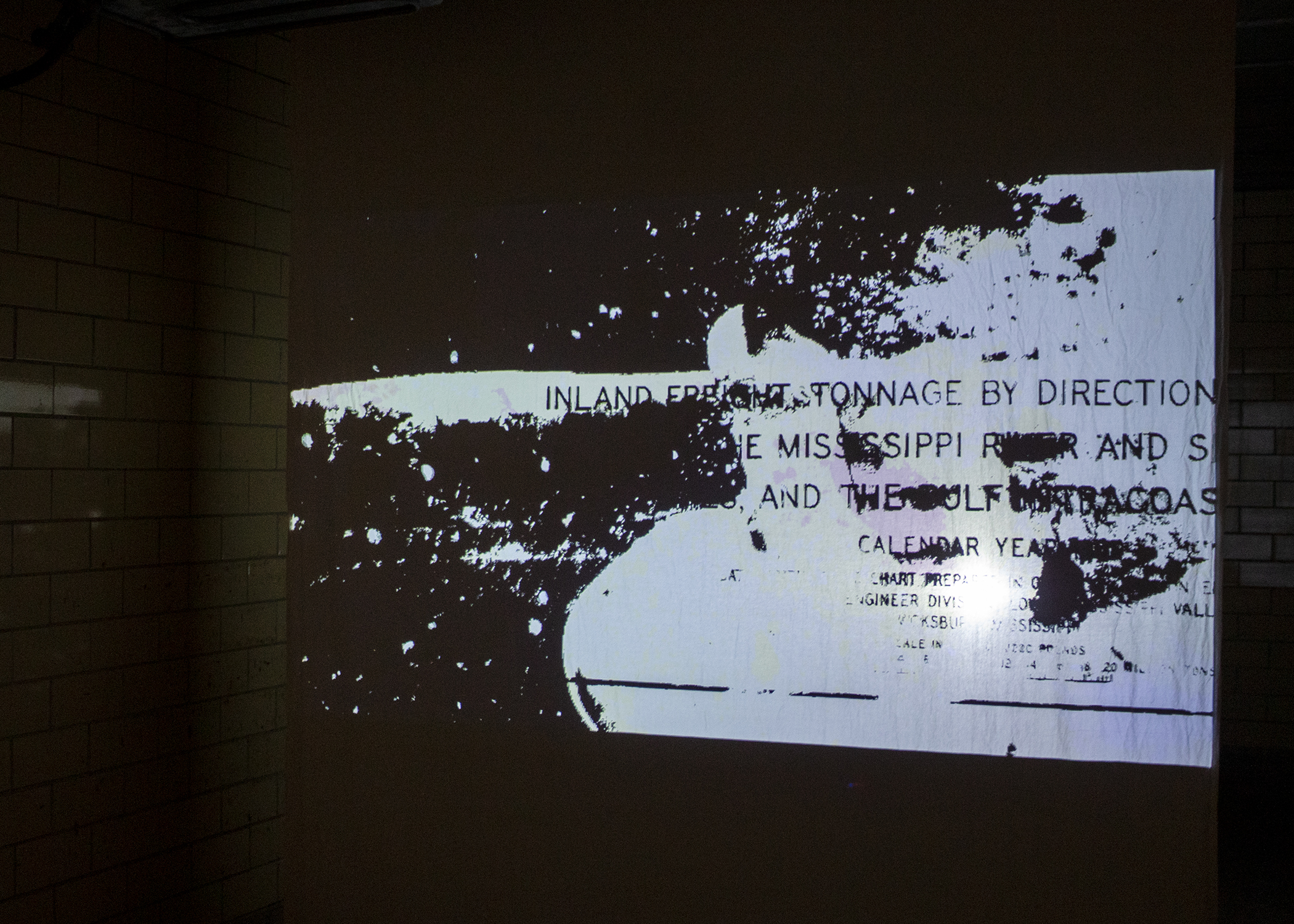
Productive Bodies, Procedurally generated audiovisual installation. (© Chelsea Thompto)
Somatic Montage: Supra-dimensional Composition in Cinema and the Arts
Clea T. von Chamier-Waite
This dissertation initiates a new cinematic language – somatic montage. A language specific to immersive cinema is an area of cinema theory neglected up until now. The formal multivalency of hyper-cinemas occupies a post-cinematic, critical space between film and media theory, art history, and art-science-technology. Somatic montage describes an embodied approach to narrative composition occupying three and higher dimensions of space-time. We examine proprioceptions, memory, and synaesthesia in experiencing artworks, proposing a new montage syntax specific to immersive, supra-dimensional cinema. The four-dimensional tesseract provides a useful model-metaphor for space-time, spatio-temporal ambiguity, perspectival faceting via multiple viewpoints, and the subjective participation of the viewer in an unfolding narrative.
We examine the impact of early 20th-century scientific discoveries on the arts, followed by a brief spatial history of montage from linear-temporal film montage, to multi-layered spatial montage in two dimensions, assemblage in three dimensions, and somatic montage – montage in (4:n)-dimensions. Advances in neuroscience establish the somatosensory conceptualization of multi-dimensional information, supporting supra-dimensional composition.
We illustrate relevant examples of somatic montage in contemporary and historical artforms: hyper-cinemas, video art, multi-projection installations, panoramas, experimental film, stereoscopy, holography, fulldome, 360°-cinema, and virtual and augmented reality. A detailed analysis of Ice-Time, an immersive, multi-channel audiovisual installation, concludes this research and demonstrates the significance of interdisciplinary art-science research.
Clea von Chamier-Waite, cleawaite@gmail.com. Ph.D., University of Southern California, 2019.
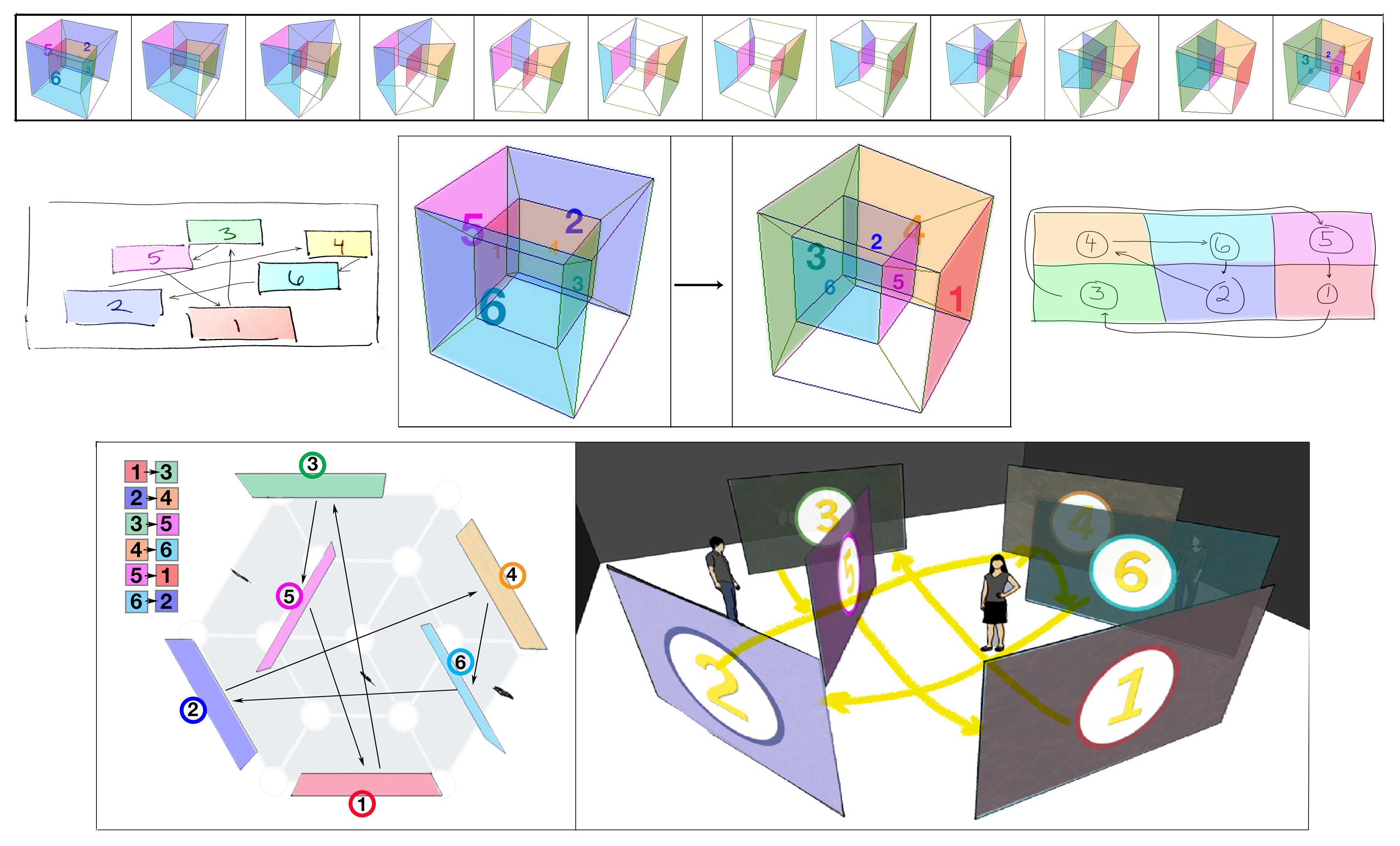
Somatic montage in Ice-Time emulates facets of a tesseract rotating through three-space. (© 2019 Clea von Chamier-Waite)
Unveiling Interfaces: A Software Studies Board Game for Algorithmic Literacy
Karla Zavala and Adriaan Odendaal
There has been growing concern over the role algorithmic systems have come to play in our digitized lives. Not only are algorithms blackboxed behind the software interfaces through which we interact with them, but so too are the ways in which they mediate, moderate, and augment our worlds. Consequently, there has been a wide-spread call from civic organisations, academics, and critics for initiatives that can foster public algorithmic literacy. This would allow those who engage with algorithmic systems in their daily lives to become more aware of, critical, and knowledgeable about how, when, and to what ends these automated systems impact their lives. Working with a practice-led research method we developed Unveiling Interfaces, a critical board game aimed at contributing to this literacy. The game was designed by codifying the game elements and mechanisms with theoretical insights from software studies, a field which, we argue, can promote such algorithmic literacy through its digital materialist approach conceptualizes algorithms as have material relations to the world through their socio-technical assemblage. In addition, this thesis also draws on approaches from game design, critical play, and critical theory through an iterative process of design and research forming part of our practical and theoretical response to the growing call for public algorithmic literacy.
Adriaan Odendaal & Karla Zavala, adriaan.odendaal1@gmail.com, kzavalabarreda@gmail.com, Master’s thesis, Aalborg University, 2018.
